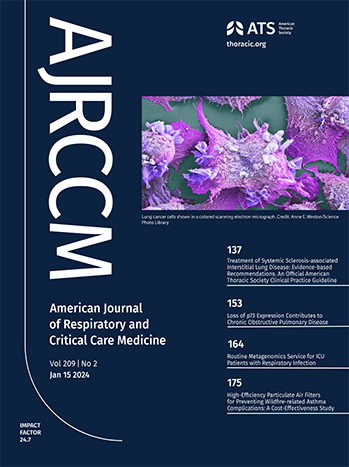低氧性呼吸衰竭的氧合目标与长期认知和肺功能。
IF 19.4
1区 医学
Q1 CRITICAL CARE MEDICINE
American journal of respiratory and critical care medicine
Pub Date : 2025-09-08
DOI:10.1164/rccm.202412-2499oc
引用次数: 0
摘要
在重症监护病房(ICU)患者中,较低的氧合目标可能损害长期认知功能,而较高的氧合目标可能损害长期肺功能。目的评估动脉氧分压(PaO2)目标为60mmhg vs 90mmhg对急性低氧性呼吸衰竭ICU存活患者1年认知功能和肺功能的影响。方法将3654例患者随机分为ICU处理氧合目标组和COVID-19处理氧合目标组,1年生存率为1916例(52.4%),1244例(64.9%)符合条件。我们评估了两个预先计划的一年结果:认知功能,使用神经心理状态评估可重复电池(rban)的整体评分来测量,以及肺功能,以预测的一氧化碳扩散能力(DLCO)的百分比来评估。测量和主要结果纳入417/1244(33.5%)例符合条件的幸存者,占原始试验人群的11.4%。低氧合组187例患者(平均78例[标准差(SD) 19])和高氧合组188例患者(平均76例[SD 21])获得总体rban评分(校正平均差(MD): 2, 95%可信区间(CI) -2至6)。低氧合组192例(平均68% [SD 22% -点])和高氧合组195例(平均73% [SD 25% -点])测量DLCO(校正MD: - 5% -点,95% CI -9至- 1% -点)。结论:在为期一年的随访中,ICU低氧性呼吸衰竭患者PaO2标靶为60mmhg与90mmhg似乎会导致相似的认知功能障碍,但可能会降低肺弥散能力。本文章由计算机程序翻译,如有差异,请以英文原文为准。
Oxygenation Targets and Long-Term Cognitive and Pulmonary Functions in Hypoxemic Respiratory Failure.
RATIONALE
In intensive care unit (ICU) patients lower oxygenation targets may impair long-term cognitive function, while higher targets may impair long-term pulmonary function.
OBJECTIVES
To assess the effects of a partial pressure of arterial oxygen (PaO2) target of 60 vs 90 mmHg on one-year cognitive and pulmonary functions in ICU survivors of acute hypoxemic respiratory failure.
METHODS
3654 patients were randomized in the Handling Oxygenation Targets in the ICU and the Handling Oxygenation Targets in COVID-19 trials: 1916 (52.4%) survived at one year, and 1244 (64.9% of survivors) were eligible. We assessed two preplanned one-year outcomes: cognitive function, measured using the global score of the Repeatable Battery for the Assessment of Neuropsychological Status (RBANS), and pulmonary function, evaluated as the percentage of predicted diffusion capacity for carbon monoxide (DLCO).
MEASUREMENTS AND MAIN RESULTS
417/1244 (33.5%) eligible survivors were included, representing 11.4% of the original trial population. Global RBANS score was obtained in 187 survivors in the lower-oxygenation group (mean 78 [standard deviation (SD) 19]) and 188 in the higher-oxygenation group (mean 76 [SD 21]) (adjusted mean difference (MD): 2, 95% confidence interval (CI) -2 to 6). DLCO was measured in 192 survivors in the lower-oxygenation group (mean 68% [SD 22 %-points] and 195 in the higher-oxygenation group (mean 73% [SD 25 %-points]) (adjusted MD: -5 %-points, 95% CI -9 to -1 %-points).
CONCLUSIONS
A PaO2 target of 60 vs 90 mmHg in ICU appeared to result in similar cognitive impairment but might reduce pulmonary diffusion capacity in ICU survivors of hypoxemic respiratory failure included in this one-year follow-up.
求助全文
通过发布文献求助,成功后即可免费获取论文全文。
去求助
来源期刊
CiteScore
27.30
自引率
4.50%
发文量
1313
审稿时长
3-6 weeks
期刊介绍:
The American Journal of Respiratory and Critical Care Medicine focuses on human biology and disease, as well as animal studies that contribute to the understanding of pathophysiology and treatment of diseases that affect the respiratory system and critically ill patients. Papers that are solely or predominantly based in cell and molecular biology are published in the companion journal, the American Journal of Respiratory Cell and Molecular Biology. The Journal also seeks to publish clinical trials and outstanding review articles on areas of interest in several forms. The State-of-the-Art review is a treatise usually covering a broad field that brings bench research to the bedside. Shorter reviews are published as Critical Care Perspectives or Pulmonary Perspectives. These are generally focused on a more limited area and advance a concerted opinion about care for a specific process. Concise Clinical Reviews provide an evidence-based synthesis of the literature pertaining to topics of fundamental importance to the practice of pulmonary, critical care, and sleep medicine. Images providing advances or unusual contributions to the field are published as Images in Pulmonary, Critical Care, Sleep Medicine and the Sciences.
A recent trend and future direction of the Journal has been to include debates of a topical nature on issues of importance in pulmonary and critical care medicine and to the membership of the American Thoracic Society. Other recent changes have included encompassing works from the field of critical care medicine and the extension of the editorial governing of journal policy to colleagues outside of the United States of America. The focus and direction of the Journal is to establish an international forum for state-of-the-art respiratory and critical care medicine.

 求助内容:
求助内容: 应助结果提醒方式:
应助结果提醒方式:


